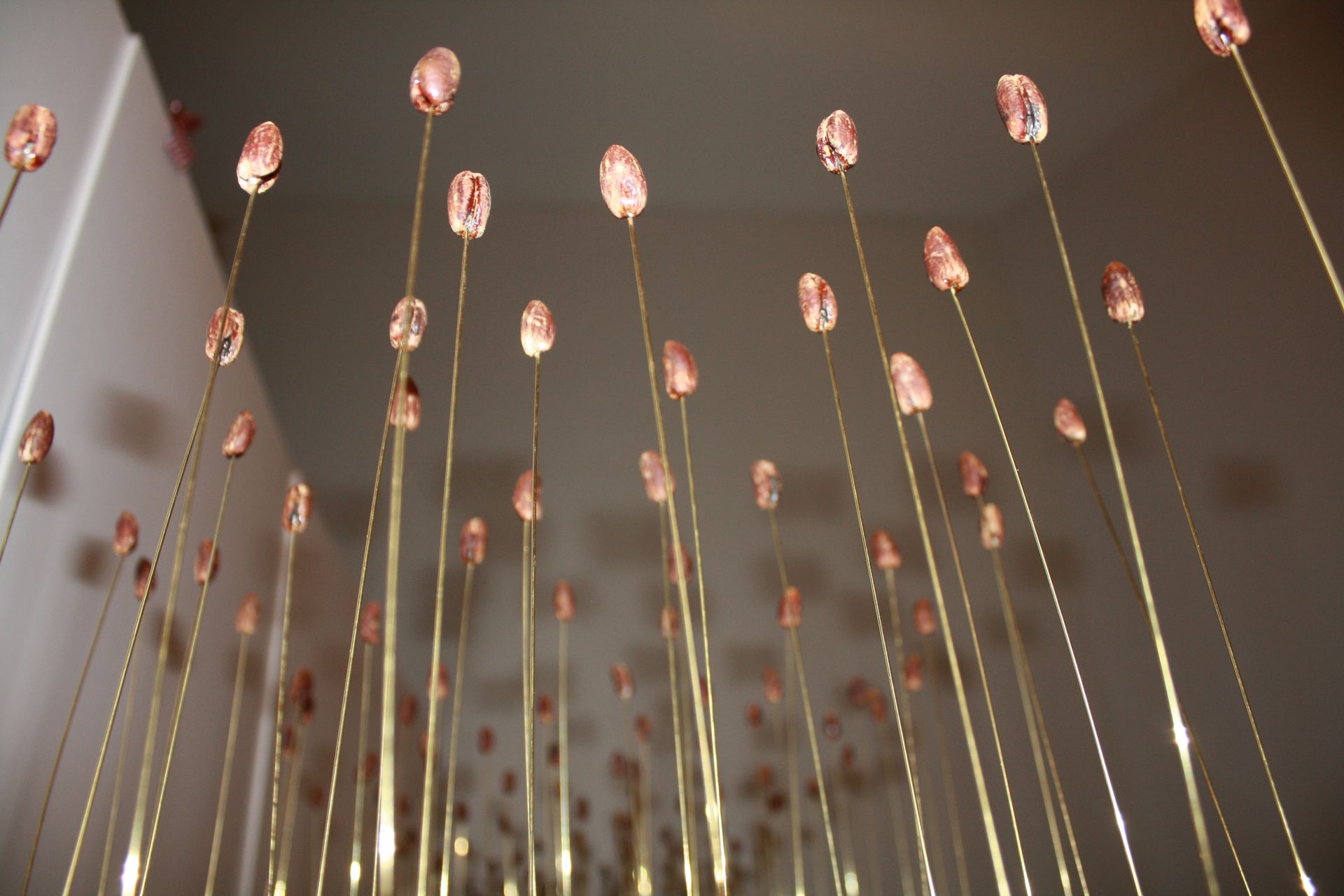ART IN THE MODERN SAUDI ARABIA
Artist. Writer. Educator.
And even more.
Dr. Fatema Al Qahtani is a complete artist and a very special literary subject.
Saudi artist woman with a multitude of creative emotions, feelings that lead her on a complex, wonderful, diverse artistic path.
The Kingdom of Saudi Arabia has become one of the world's cultural destinations thanks to the modern visions of the young Crown Prince Mohammed Bin Salman, who has given freedom of artistic expression to the new young generations.
Dr. Fatema Al Qahtani is one of the many Saudi artists who seek and explore through her ambitious and innovative ideas, her personal artistic territory, the voice of her own feminine creativity.
Nothing is more interesting than the common artistic language, based on multicultural friendship. As a European writer I am always excited and very enthusiastic to be able to lead a cross cultural conversation with a writer, artist and high class intellectual representing another culture, especially the Saudi culture.
I consider the Kingdom of Saudi Arabia a huge treasure of culture, traditional Arab heritage, old customs and ancient history.

The new modern society that is developing very rapidly now in Saudi Arabia brings us great surprises, especially on the cultural, artistic level.
Numerous traditional and modern art exhibitions take place locally and internationally, bringing into the spotlight the creative talents of Saudi Arabia, especially women with a strong role in supporting women empowerment.
Dr. Fatema Al Qahtani is not only a Saudi artist but also a personality with an educational role in the society.
Let us discover the artist, the writer and the educator Fatema Al Qahtani and in the same time, let us know more about the unique Saudi Arabian spirituality.
Do you describe yourself as a Saudi artist or an international artist?
 A Saudi artist who belongs to Islamic culture, I am also a part of a broader circle of the global community. Art is a universal language that transcends word barriers as the image can be understood not only by art specialists and critics but by any human being able to feel, see, listen and touch.
A Saudi artist who belongs to Islamic culture, I am also a part of a broader circle of the global community. Art is a universal language that transcends word barriers as the image can be understood not only by art specialists and critics but by any human being able to feel, see, listen and touch.
The global art connection has made the world closer and more integrated, as the language of art can be understood by any recipient from any ethnic or cultural background. The chance of expanding an artist's influence increases when he/she embraces the major existential issues that represent every human being on this earth by focusing on the meaning of our common existential purpose that we share.
Do you think your artistic activity is a symbol of women's empowerment?
There is no doubt that expression, whatever its form, is an effective tool of empowerment the independent artist who is capable of expressing his point of view through creative forms has the opportunity to reach people’s minds and make a positive conceptual change.
Practicing art and producing new creative concepts are the most important manifestations of the idea of empowerment. The independent artist, whether man or woman, enjoys the process of decision-making by creating a new philosophy, this is in line with the meaning of the “right to choose”. In short, having the space to make choices through art is a strong empowerment for women.
How do you describe modern Saudi society and what is more inspiring to you?
The Saudi individuals have a unique and special experience, as the adherence to their socio-religious roots did not prevent them from coexisting with the world and identifying with the cosmopolitan system. The Islamic/Arabic Saudi cultural setting is deeply religious, conservative and family-oriented. Arabic tribal norms in Saudi Arabia are centuries-old, derived from Islamic/Arabic civilization, though, these components are rooted deeply in the Saudi individual. The current cultural awakening has proven the extent of the flexibility of the Saudi individual in terms of coexisting with other cultures and, at the same time, keeping his feet on solid ground.
Indeed, there is a misconception that we need to water-down our culture, heritage and language to be palatable and accepted by an international audience which is not true. We have our identity which has a very unique point of view.

When did you start your art career and what was the driving motor making you to be creative?
It is not a cliché answer if I say that my creative tendency has begun since childhood. I remember how I was eagerly waiting for art classes. I was lucky enough to have wonderful art teachers who recognized and encouraged my talent. I also was awarded a local art prize during my high school on the level of Riyadh city, which increased my confidence in my talent early on.
My professional art practice began during my academic studies in 2007, which extended through my bachelor, master and PhD which was in the creative practice field.
In this regard, I owe a special thanks to my father, Abdullah, who played a vital role in my artistic confidence, as he always believed in me and some ambitious artworks that I attempted to do.
What is your motivation for being an artist?
My art isn't subject to motivations as I deal with it as a necessity, in other words, art-making is not a mere passion, it's a truly responsible stance that emerges in the creative doing. Art is a multifaceted phenomenon, that makes life more meaningful, understandable and attractive. Art serves as an archive of history, embodiment of societal values, and commenting on political or social events.
I didn’t exaggerate if I consider art as a fuel for our mental well-being, interaction, empathy and a trigger for positive change.
Have you been, or are you inspired, influenced by an international artist or other Saudi artist in your creativity?
The artist is a being who grows and interacts so there is no doubt that I have also been influenced by both local and international art movements. Thinkers/artists use different original perspectives to represent the visual world, both in the artistic and metaphorical sense, however, I believe in that absolute originality in producing ideas is impossible, as various sources influence us and we naturally build our creativity from different sources. Creative expression knows no boundaries, and throughout history, the interaction of ideas between Eastern and Western cultures. Being inspired by others means that you have a sharp eye for cultural comparison, and you are smart enough to hone your own personal art experience.
How do you describe your own artistic personality?
My artistic personality is simple, authentic and expandable
I truly believe in Leonardo Da Vinci's quote "Simplicity is the ultimate sophistication". I truly believe that simple things have a high value when without extra frills and complexity. Genius is making complex ideas simple, not making simple ideas complex and this absolutely could apply to art.
My authenticity is about the process of opening up and allowing myself to be spilled into some form of creativity that represents my identity. Being authentic demands courage to be you in the unlimited world. It is risk-taking achieved only when your art is practiced away from popular opinion, and at the same time, doesn't try to shock others. Ultimately, art authenticity is trusting that your expression is valid regardless if it pleasing to others or not.
Developing expandable and infinity patterns from Islamic art is the key technique of my creative process. Through my artworks, I respond to the female Saudi artistic experience by developing these patterns to explore ideas of containment and freedom. The Islamic grid pattern is an essential ingredient and a clear thread across my artworks, which include painting, drawing, digital media and spatial art. Drawing inspiration from Islamic art and religion, I express ideas such as unity and infinity to explore the boundaries of conservative Saudi society.
What are your personal experiences and expectations as Saudi artist?
Through the process of art practice itself, an artist's experiences vary in quantity and quality. Based on my own experience, my artistic experiences at the beginning of my career differ from my current art production in terms of the philosophical and technical dimensions. As the saying goes, PRACTICE MAKES PERFECT, so engaging in art practice in different ways and going through all ups and downs, successes or frustrating, is the key to refining the artist’s personality.
As for my expectations, indeed, I have no specific expectations other than to keep working and reaching a higher level of my creative practice and to be always the best version of myself.

Where do you feel more creative, at home in Saudi Arabia or when you are traveling?
This is a good question.
Based on my own experience, a moment of inspiration or a spark of passion could happen everywhere anytime, and I believe that all creative people share this. For example, I could get a fabulous idea through meditation, workout, driving or even taking a shower! Idea-making is a developed process that flourishes through calculated steps, such as writing, improvement and sketching. In short, if I am not present to inspiration I find myself present to something else so the feeling changes as the focus changes.
I feel inspired many times in different circumstances as long as I am present with the ideas that I formed, framed and visualized.
What is your artistic, professional commitment a Saudi woman and Saudi artist and which place in Saudi Kingdom gives you emotional creativity?
The phrase "professional commitment,” is an accurate and significant term to describe productive a meaningful work.
As an academic/artist, my professional commitment has two aspects, practical as an artist, and theoretical as an academic professor.
My artistic commitment is evident in continuing diligent practice and development so that my art develops and flourishes philosophically and technically. The impetus for art practicing itself is commitment which requires consistency with what you believe and using art as a vehicle to share respect and exchange the highest values.
My professional commitment as an academic is based on producing knowledge that is related to creative practice through research papers, books and articles.
Being an academic artist demands foresight and the ability to distinguish between my roles as an academic researcher and a practitioner artist at the same time.

Through her artistic creations, the artist Fatemah Al Qahtani offers us the opportunity to look in depth at the new modern Saudi society and understand the cultural development project, part of the 2030 Visionary objective that leads the Kingdom of Saudi Arabia to a multilaterally developed Era of highest accomplishment and development.
It is the right time and the best opportunities for Saudi young generation of artists to be welcomed and presented to the most important European art galleries, cultural events opening the doors for a large cross cultural cooperation and communication.
We are saying A BIENTOT dear Fatemah Al Qahtani.
Interview by Dr. Monica Mergiu





ROYAL ARTS VISIONS; ART IN THE MODERN SAUDI ARABIA